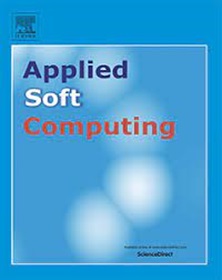基于最优关注的具有长短期记忆层的多尺度密集神经网络的疫情假新闻智能检测模型
IF 7.2
1区 计算机科学
Q1 COMPUTER SCIENCE, ARTIFICIAL INTELLIGENCE
引用次数: 0
摘要
假新闻最近利用网络网站的力量和范围有效地传播错误信息,侵蚀了人们对新闻和新闻业的信心,同时也操纵了公众的看法和情绪。然而,互联网上出现的许多信息都是可疑的,甚至是有意误导的。一些假新闻与真实新闻如此相似,以至于人类很难识别它们。因此,假新闻检测需要开发有效的模型来克服现有的挑战。因此,在本文中,开发了一种新的深度学习方法来识别大流行情况下的假新闻。最初,从与大流行情况有关的基准资源中收集文本数据,并提供给预处理阶段。然后将得到的预处理数据输入到特征提取过程中。在这里,使用手套嵌入、双向编码器表示从变压器(BERT)和词频逆文档频率(TFIDF)提取特征。然后,将提取的特征进行融合最优加权特征选择,利用基于更新随机变量的人工兔子优化算法(URV-ARO)对权重进行优化。然后将得到的最优加权特征交给分类过程。在分类阶段,利用基于最优注意的长短期记忆层多尺度密度网络(OAMDNet-LSTM)对假新闻进行分类。此外,利用开发的URV-ARO对densenet和LSTM中的参数进行了调优。优化DenseNetand LSTM中的参数有助于对模型进行微调,从而在区分真假新闻方面达到更高的准确性。该模型的有效性通过传统方法验证,以展示其他方法的有效性。本文章由计算机程序翻译,如有差异,请以英文原文为准。
An intelligent feature selection-based fake news detection model for pandemic situation with optimal attention based multiscale densenet with long short-term memory layer
Fake news has recently used the strength and scope of online networking sites to efficiently propagate misinformation, eroding confidence in the press and journalism while also manipulating public perceptions and emotions. However, much information appearing on the Internet is dubious and even intended to mislead. Some fake news is so similar to the real ones that it is difficult for humans to identify them. Therefore, Fake News Detection (FND) needs to develop effectual models to overcome the existing challenges. So, in this paper, a novel deep-learning approach is developed for the recognition of fake news in pandemic situations. Initially, text data are collected from benchmark resources related to the pandemic situation and provided to the pre-processing stage. Then, the obtained pre-processed data is inputted into the feature extraction process. Here, the features are extracted using glove embedding, Bidirectional Encoder Representations from Transformers (BERT), and Term Frequency Inverse Document Frequency (TFIDF). Later, the extracted features are taken to the fused optimal weighted feature selection, and the weights are optimized using the Updated Random Variable-based Artificial Rabbits Optimization (URV-ARO), leveraging the Artificial Rabbits Optimization (ARO). The attained optimal weighted features are then given to the classification process. In the classification phase, the fake news is classified with the help of Optimal Attention-based Multiscale Densenet with Long Short-Term Memory layer (OAMDNet-LSTM). Moreover, parameters in DenseNetand LSTM are tuned by developed URV-ARO. Optimizing parameters in the DenseNetand LSTM helps fine-tune the model to achieve higher accuracy in distinguishing between genuine and fake news. The effectiveness of the proposed model is validated with conventional approaches to showcase the effectiveness of others.
求助全文
通过发布文献求助,成功后即可免费获取论文全文。
去求助
来源期刊

Applied Soft Computing
工程技术-计算机:跨学科应用
CiteScore
15.80
自引率
6.90%
发文量
874
审稿时长
10.9 months
期刊介绍:
Applied Soft Computing is an international journal promoting an integrated view of soft computing to solve real life problems.The focus is to publish the highest quality research in application and convergence of the areas of Fuzzy Logic, Neural Networks, Evolutionary Computing, Rough Sets and other similar techniques to address real world complexities.
Applied Soft Computing is a rolling publication: articles are published as soon as the editor-in-chief has accepted them. Therefore, the web site will continuously be updated with new articles and the publication time will be short.
 求助内容:
求助内容: 应助结果提醒方式:
应助结果提醒方式:


